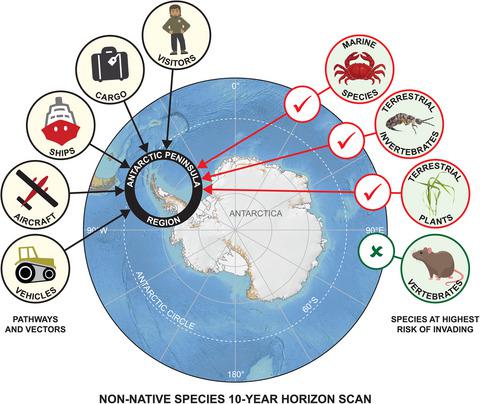当前位置:
X-MOL 学术
›
Glob. Change Biol.
›
论文详情
Our official English website, www.x-mol.net, welcomes your
feedback! (Note: you will need to create a separate account there.)
Invasive non-native species likely to threaten biodiversity and ecosystems in the Antarctic Peninsula region.
Global Change Biology ( IF 10.8 ) Pub Date : 2020-01-13 , DOI: 10.1111/gcb.14938 Kevin A Hughes 1 , Oliver L Pescott 2 , Jodey Peyton 2 , Tim Adriaens 3 , Elizabeth J Cottier-Cook 4 , Gillian Key 5 , Wolfgang Rabitsch 6 , Elena Tricarico 7 , David K A Barnes 1 , Naomi Baxter 8 , Mark Belchier 9 , Denise Blake 8 , Peter Convey 1 , Wayne Dawson 10 , Danielle Frohlich 11 , Lauren M Gardiner 12 , Pablo González-Moreno 13, 14 , Ross James 9 , Christopher Malumphy 15 , Stephanie Martin 16 , Angeliki F Martinou 17 , Dan Minchin 18 , Andrea Monaco 19 , Niall Moore 5 , Simon A Morley 1 , Katherine Ross 20 , Jonathan Shanklin 1 , Katharine Turvey 2 , David Vaughan 1 , Alexander G C Vaux 21 , Victoria Werenkraut 22 , Ian J Winfield 2 , Helen E Roy 2
Global Change Biology ( IF 10.8 ) Pub Date : 2020-01-13 , DOI: 10.1111/gcb.14938 Kevin A Hughes 1 , Oliver L Pescott 2 , Jodey Peyton 2 , Tim Adriaens 3 , Elizabeth J Cottier-Cook 4 , Gillian Key 5 , Wolfgang Rabitsch 6 , Elena Tricarico 7 , David K A Barnes 1 , Naomi Baxter 8 , Mark Belchier 9 , Denise Blake 8 , Peter Convey 1 , Wayne Dawson 10 , Danielle Frohlich 11 , Lauren M Gardiner 12 , Pablo González-Moreno 13, 14 , Ross James 9 , Christopher Malumphy 15 , Stephanie Martin 16 , Angeliki F Martinou 17 , Dan Minchin 18 , Andrea Monaco 19 , Niall Moore 5 , Simon A Morley 1 , Katherine Ross 20 , Jonathan Shanklin 1 , Katharine Turvey 2 , David Vaughan 1 , Alexander G C Vaux 21 , Victoria Werenkraut 22 , Ian J Winfield 2 , Helen E Roy 2
Affiliation

|
The Antarctic is considered to be a pristine environment relative to other regions of the Earth, but it is increasingly vulnerable to invasions by marine, freshwater and terrestrial non-native species. The Antarctic Peninsula region (APR), which encompasses the Antarctic Peninsula, South Shetland Islands and South Orkney Islands, is by far the most invaded part of the Antarctica continent. The risk of introduction of invasive non-native species to the APR is likely to increase with predicted increases in the intensity, diversity and distribution of human activities. Parties that are signatories to the Antarctic Treaty have called for regional assessments of non-native species risk. In response, taxonomic and Antarctic experts undertook a horizon scanning exercise using expert opinion and consensus approaches to identify the species that are likely to present the highest risk to biodiversity and ecosystems within the APR over the next 10 years. One hundred and three species, currently absent in the APR, were identified as relevant for review, with 13 species identified as presenting a high risk of invading the APR. Marine invertebrates dominated the list of highest risk species, with flowering plants and terrestrial invertebrates also represented; however, vertebrate species were thought unlikely to establish in the APR within the 10 year timeframe. We recommend (a) the further development and application of biosecurity measures by all stakeholders active in the APR, including surveillance for species such as those identified during this horizon scanning exercise, and (b) use of this methodology across the other regions of Antarctica. Without the application of appropriate biosecurity measures, rates of introductions and invasions within the APR are likely to increase, resulting in negative consequences for the biodiversity of the whole continent, as introduced species establish and spread further due to climate change and increasing human activity.
中文翻译:

外来入侵物种可能威胁南极半岛地区的生物多样性和生态系统。
相对于地球其他地区,南极洲被认为是一个原始环境,但它越来越容易受到海洋、淡水和陆地非本地物种的入侵。南极半岛地区(APR)包括南极半岛、南设得兰群岛和南奥克尼群岛,是迄今为止南极大陆遭受入侵最严重的地区。随着人类活动强度、多样性和分布的预计增加,入侵性非本地物种引入亚太地区的风险可能会增加。《南极条约》签署国呼吁对非本地物种风险进行区域评估。作为回应,分类学和南极专家利用专家意见和共识方法进行了地平线扫描工作,以确定未来 10 年内可能对亚太地区生物多样性和生态系统构成最高风险的物种。目前在 APR 中不存在的 103 个物种被确定为需要审查的相关物种,其中 13 个物种被确定为存在入侵 APR 的高风险。海洋无脊椎动物在最高风险物种名单中占主导地位,开花植物和陆生无脊椎动物也有代表性;然而,脊椎动物物种被认为不太可能在 10 年内在 APR 中定居。我们建议 (a) 积极参与 APR 的所有利益相关者进一步制定和应用生物安全措施,包括对在这次地平线扫描演习中发现的物种进行监测,以及 (b) 在南极洲其他地区使用这种方法。如果不采取适当的生物安全措施,亚太地区的引进和入侵率可能会增加,因为气候变化和人类活动增加导致引进物种进一步建立和传播,从而对整个大陆的生物多样性造成负面影响。
更新日期:2020-01-13
中文翻译:

外来入侵物种可能威胁南极半岛地区的生物多样性和生态系统。
相对于地球其他地区,南极洲被认为是一个原始环境,但它越来越容易受到海洋、淡水和陆地非本地物种的入侵。南极半岛地区(APR)包括南极半岛、南设得兰群岛和南奥克尼群岛,是迄今为止南极大陆遭受入侵最严重的地区。随着人类活动强度、多样性和分布的预计增加,入侵性非本地物种引入亚太地区的风险可能会增加。《南极条约》签署国呼吁对非本地物种风险进行区域评估。作为回应,分类学和南极专家利用专家意见和共识方法进行了地平线扫描工作,以确定未来 10 年内可能对亚太地区生物多样性和生态系统构成最高风险的物种。目前在 APR 中不存在的 103 个物种被确定为需要审查的相关物种,其中 13 个物种被确定为存在入侵 APR 的高风险。海洋无脊椎动物在最高风险物种名单中占主导地位,开花植物和陆生无脊椎动物也有代表性;然而,脊椎动物物种被认为不太可能在 10 年内在 APR 中定居。我们建议 (a) 积极参与 APR 的所有利益相关者进一步制定和应用生物安全措施,包括对在这次地平线扫描演习中发现的物种进行监测,以及 (b) 在南极洲其他地区使用这种方法。如果不采取适当的生物安全措施,亚太地区的引进和入侵率可能会增加,因为气候变化和人类活动增加导致引进物种进一步建立和传播,从而对整个大陆的生物多样性造成负面影响。









































 京公网安备 11010802027423号
京公网安备 11010802027423号